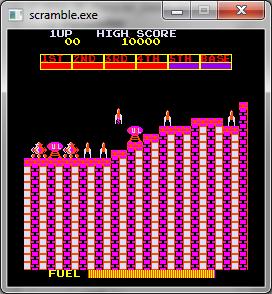I've completed the game lifecycle mechanics and fixed a few bugs in the process. Somewhat interestingly, in two completely different routines I had omitted the instructions that reset the column scroll values in the C code. Strange coincidence.
But you can now coin up and play 1P or 2P games through to completion and back to attract mode.
 |
| 2P game in action |
There are a few odd bits of code in there, such as specifically copying two one-byte data values from memory (a level value and a flag) over the storage for a pointer; they're never read back and that same copy is done in two places. However it's benign because the pointer is re-initialised before it is used again. I'm scratching my head wondering how that could have gone unnoticed in the assembler source.
I've only got two reasonbly trivial routines that I can't test to go besides all the the routines related to player bullets & bombs and their collisions and explosions. Those routines simply check if an extra life should be awarded (based on score) and also display the 'mission complete' flags.
Looking at the source code after yet another cleanup I'd estimate it to be around 80% complete. There's nothing new in those routines that hasn't been transcoded already, and a lot of it will be cut and paste. Whilst the code is nicely structured and lends itself very readily to a C transcode, there is a reasonable amount of very similar and in some cases outright duplicate code.
From here there's a couple of days of work in the bullets and bombs and then it'll be play testing.
I'm yet to transcode any audio-related routines. The audio control simply involves writing sound ordinal values to the sound CPU (another Z80) which controls a pair of AY8910 sound chips. I'm not intending on porting any audio at this point, but will probably add stubs for the audio routines so that sound may be added at some point in the future, even if not by me.


















